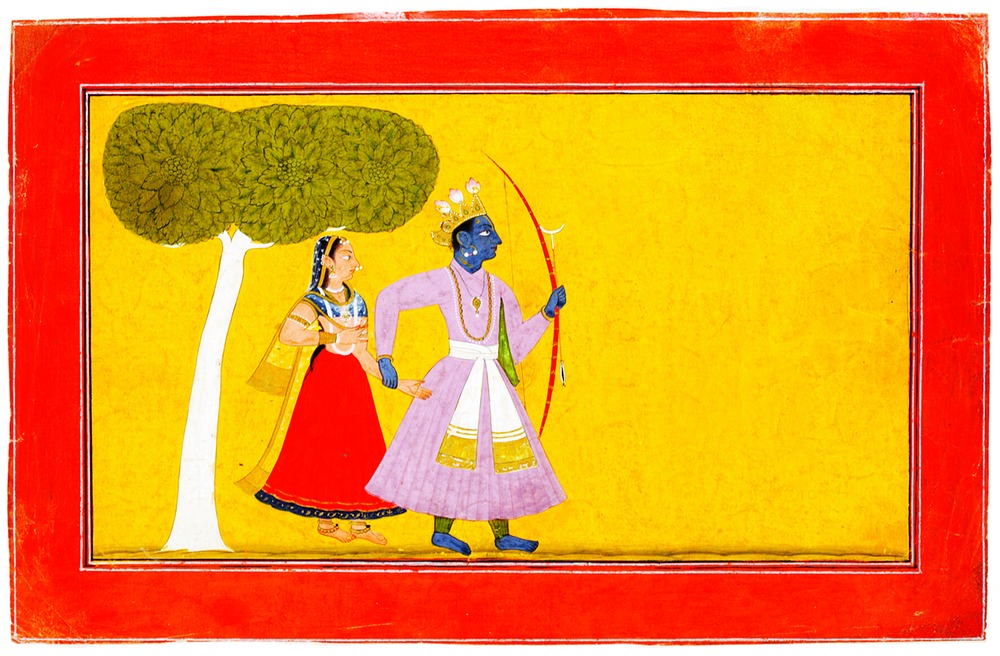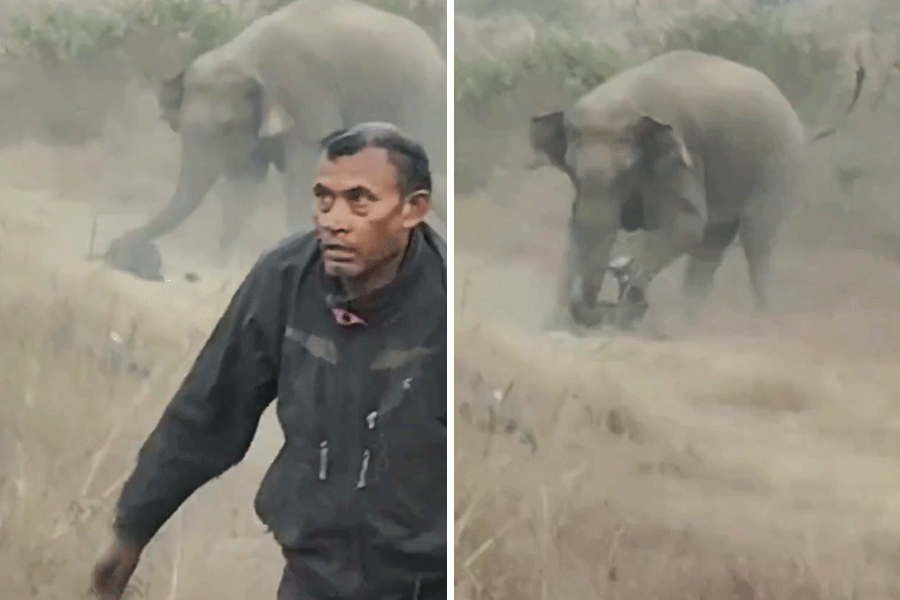
How do you begin a story about the epics?
Why? As it should. In the middle of the rough and tumble.
The poll bugle has been sounded in Uttar Pradesh, elections are round the corner. The Bharatiya Janata Party (BJP) is not unwilling to bank on Ram. The Samajwadi Party (SP) is willin'. The olden promise of a Ram temple at Ayodhya has been resurrected. The Centre has announced a Rs 200-crore Ram museum. The SP government, a Ramleela Park. IRCTC is offering something called the Ramayana Yatra. In another part of the country, a heavy-duty civic body - the Brihanmumbai Municipal Corporation - is set to go to the polls too. A new local railway station has come up for Mumbaikars. Its name - Ram Mandir, altered from the earlier Oshiwara.
At such a time, at a fair remove from politics, the creative world is busy with tangential predilections: re-imagining the epics and giving to them, and us, new meanings.

circa 1720; Museum Rietberg Zurich
2016. Harper Perennial published The Liberation of Sita, a translation of Telugu writer Volga's Vimukta. HarperCollins published Trisha Das's Ms Draupadi Kuru: After the Pandavas and Amruta Patil's Sauptik. Hachette came out with Krishna Udayasankar's Immortal. This month, Rupa came out with Kavita Kane's Lanka's Princess.
Sometime around Diwali, Raizada Rohit Jaisingh Vaid's Mahayoddha Rama, a 3D animation film, hit cineplexes across the country. Continents away, The Rama Epic: Hero, Heroine, Ally and Foe, a three-month-long exhibition opened at the Asian Art Museum (AAM) in San Francisco. India's mythology man, Devdutt Pattanaik, has already addressed a series of talks in the US, under the broad title "Mythology for Global Harmony". Benoy Behl's film Ramayana: The Greatest Epic premiered at the AAM this week.
"Myth and stories may not be history but they are a collection of our past memories through which we build our future. Any single narrative makes them redundant," says Vinay Kumar, artistic director of theatre group Adishakti. Kumar has also written the play, The Tenth Head. In it, nine of the 10 heads of Ravana are a company, happy to conform to a common way of seeing things. Each represents one of the nine bhavas from the traditional Indian aesthetic. The tenth is the odd man out. And the play is the struggle of the tenth head for some headroom, if you will.
Adishakti factors in audience and community feedback to evolve its productions. Says Kumar, "From the time of its debut [2014], Tenth Head was able to make rapid changes and have greater clarity in its aesthetics and underlying political debate."

illustrator Andrea Nguyen
Vaid, the director of Mahayoddha Ram, did not have Kumar's advantage of remoulding the narrative, but interpret he did. He says, "Ravana has 10 heads, a given, but they all talk and there is a lot of discussion between them, symptomatic of much confusional drama. One of the heads is muphat (a blunt talker), another a Vishnu bhakt and so on. He is a madcap politician, has been trying to kill Rama forever, but is always worried about his reputation and the breaking news."
Vaid's film, its title notwithstanding, is told from Ravana's point of view.
Kavita Kane is the author of such re-tellings as Sita's Sister, Karna's Wife: The Outcast's Queen and Menaka's Choice. In Lanka's Princess she goes hyper liminal. Says Kane, "Lanka's Princess is Surpanakha, Ravana's sister whose nose got lopped off. What do we know beyond that?... Mythology makes one think, not judge. That's why the huge interest and not because mythology is polemic to religion, history or controversy."
The Liberation of Sita has been translated into English by T. Vijay Kumar and C. Vijayasree. A slim volume containing five tales that will make you pause. The first, titled The Reunion, is again about Surpanakha. Volga's Surpanakha tells Sita about life after the humiliation and mutilation she suffered at the hands of Ram and Lakshman. She says: "I struggled a lot to grasp that there is no difference between beauty and ugliness in nature... my own vision has changed..."
Volga's Sita understands, but not quite. She says: "How beautiful you are... How does it matter whether any man appreciates your beauty or not." Surpanakha laughs: "Why? Don't men have eyes? Don't they have a heart? I am not talking about men who only know how to disfigure and to hate the disfigured." And it dawns on Sita, she has found both peace and love.
In 2014, Harper Perennial came out with The Vigil, a translation of Sarah Joseph's Oorukaaval by Vasanthi Sankaranarayanan, which is really the Ramayana refracted through the sensibilities of Angadan, monkey king Bali's son. Angadan's youth, his vulnerability, his anger, his helplessness as life as he knows it changes; the entire inverted narrative forces the reader to re-view the accepted story of Ramayana and Ram.
So what do we have? A conflicted Ravana instead of some clown in a bad wig seismic with laughter. A Sita who is open to taking a life lesson from Surpanakha. (Uffff. Imagine the pain of the puritans.) A monkey questioning the actions of Ram. And the maryada purushottam himself, less man, more context.
The plays, the movies, the books, they are all holding up the mirror. Did you say ulterior motive? Marketability? Saleability? Perhaps. Very likely. But there's no discounting what they are saying. They are saying open your eyes, celebrate diversity, recognise universalities. Could be confusing, though, when times are all about homogenise, divide, rule.

The organisers of The Rama Epic have neatly and cleverly broken down the universals. Hero. Heroine. Ally. Foe.
Forrest McGill is director of the Research Institute for Asian Art at AAM. Six years ago AAM started "seriously planning" The Rama Epic. He says, "It seemed to be a good topic because of the inherent fascination of its plot and characters, and of course its enormous ethical, social, and cultural importance, not just in India, but in Myanmar, Thailand, Cambodia, and Indonesia too."
An object list was drawn up - about 30 works from its own collection and around another 100 to be borrowed from over 20 museums and libraries in Europe, the UK, and around the US.
Says McGill, "We emphasise the fact that it may be surprising to see major artworks on the Ramayana from Islamic contexts in India and Indonesia and Buddhist contexts in Myanmar, Thailand, and Cambodia. There are some Rama Epic artworks made in Europe, one as early as the 1670s."
As a prelude to the exhibition, there was a talk by Devdutt Pattanaik in Palo Alto on October 4. Westland Ltd was the organiser. "The response was very positive, and we were able to organise about eight or nine talks across the US," says Deepthi Talwar, chief editor of Westland Ltd-Tranquebar Press. Is Westland looking to do something similar in India? "Not in the immediate future," says Talwar.
Pattanaik's latest take on the Ramayana, The Girl Who Chose: A New Way of Narrating the Ramayana, speaks to adult and young adult audiences alike. So why aren't such talks happening in India? Surely, a culture of tolerance should begin young and at home?
"These are new ideas. It takes time. People are still stuck in 19th century European notions that Hinduism is mythology, Christianity and Islam are religions, and secularism is about rejecting religion, science is about rejecting myths. Or they are stuck in 20th century American concepts that Hinduism is casteist and misogynist and patriarchal. The Right wing is an extreme Hindu supremacist response to these misunderstandings about Hinduism, mythology, religion and secularism. Any alternate thought, new ideas of the 21st century, takes time to seep in. We must be patient," says Pattanaik.
New ideas need new vehicles.

Shinibali Mitra Saigal is co-founder and curator of Kahani Karnival, a Mumbai-based storytelling and arts festival for children. Says Mitra Saigal, "When we do storytelling sessions around mythology or epics, we work around concepts like language or diversity or history. In the December edition of the festival in Bangalore, Roopa Pai did a session centred around her Gita, where she discussed the larger concept of diversity."
Pai's The Gita for Children was published by Hachette India in 2015. A heavily and extremely relevantly contextualised piece of work with references to Kipling and Harper Lee and Beatles thrown in not to nullify the gravity but to underline and make digestible the wisdom.
Editor-in-chief and publisher at Hachette India, Poulomi Chatterjee, says, "A French publisher I met recently was very interested in the book. She said they were looking for something that would morally ground their children because it's so easy to look around you and absorb the hate-mongering all around and grow up intolerant of anything that's different. I found it heartening that people were still looking to books to do that."
Indeed, books can do that. Take Trisha Das's Ms Draupadi Kuru, a fictional work. The author does not attempt to force-feed any "ism", but there is a message if you are looking for it. There is the bit when Draupadi, who is on a mortal vacation, comes across an astrologer. She tells him her name, and he says it is bad luck to be thus named. Das writes: "Draupadi stared at him... So that is my legacy, she thought sadly. Remembered as a woman who serviced five men..."
Says Das, "If handled with sensitivity and respect, these characters have the potential to build bridges. That's why one needs to keep reinventing them."
Tara Books published Samhita Arni's retelling of the Mahabharata (titled The Mahabharatha: A Child's View) in 1996. V. Geetha, editorial director of Tara, recalls trading tales of different versions of the epic. "The deceptively canonical version of C. Rajagopalachari; R.K. Narayan's breezy version; Kamala Subramaniam's version. I was familiar with K.M. Munshi's sprawling Krishnavatara. I remember this fascinating section where Munshi steps back from the narrative to tell us about a temple for Duryodhana in Uttarakhand, about polyandry in parts of central India..."
She adds, "I am not sure I have favourites with respect to re-tellings of either epic. Each has its own character."
The rah-rah around Ram in UP has been drowned out for now by demonetisation woes. But that's temporary. The BJP's stormy elder Subramanian Swamy has just written to the Prime Minister seeking government help on his legal petition in the Ram temple case. He said, "Development is necessary to win the elections but it's not everything."
Hey Ram!
IMAGES: THE ASIAN ART MUSEUM











